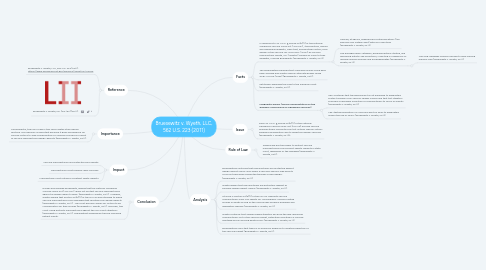
1. Conclusion
1.1. Russell and Robalee Bruesewitz, argued that the National Childhood Vaccine Injury Act (“NCVIA”) “does not protect vaccine manufacturers against all design-defect claims” (Bruesewitz v. Wyeth, 2011). However, Wyeth argued that Section 22(b)(1) of the NCVIA was intended to waive vaccine manufacturers from damaged that resulted from design defects (Bruesewitz v. Wyeth, 2011). The court decision allows for victims to be compensation for their injuries (Bruesewitz v. Wyeth, 2011). Inversely, this court ruling protects manufacturers against the civil court litigations (Bruesewitz v. Wyeth, 2011). The greatest achievement will be improved patient safety.
2. Impact
2.1. Vaccine manufacturers are protected from liability
2.2. Manufacturers must properly label vaccines
2.3. Manufacturers limit instance of patient safety defects
3. Importance
3.1. Consequently, the rule of law in this case creates stare decisis doctrine. This decision is important because it gives precedence for vaccine victims to seek compensation for injuries incurred as a result of vaccine manufacturer design-defects (Bruesewitz v. Wyeth, 2011).
4. Reference
4.1. Bruesewitz v. Wyeth, LLC, 562 U.S. 223 (2011). https://www.supremecourt.gov/opinions/10pdf/09-152.pdf
4.2. Bruesewitz v. Wyeth, Inc. (09-152) (2011).
5. Facts
5.1. In reference to 42 U.S.C. § 300aa-22(b)(1) of the National Childhood Vaccine Injury Act (“NCVIA”), “the plaintiffs, Russell and Robalee Bruesewitz, claim that, among other factors, poor design of the vaccine TRI-IMMUNOL (“DTP”) by vaccine manufacturer Wyeth, Inc. (“Wyeth”) caused an injury to their daughter, Hannah Bruesewitz” (Bruesewitz v. Wyeth, 2011).
5.1.1. Hannah, at age six, experienced contraindications (126 seizures over sixteen days) with DTP injections (Bruesewitz v. Wyeth, 2011).
5.1.2. The damages were “lethargic, developmentally stunted, and displaying autistic-like symptoms,” resulting in a diagnosis of residual seizure disorder and encephalopathy (Bruesewitz v. Wyeth, 2011).
5.1.2.1. The long-damages requires Hannah to have lifelong medical care (Bruesewitz v. Wyeth, 2011).
5.2. The Bruesewitzes believed that “Hannah’s injuries could have been avoided had Wyeth used an alternate design called ACEL-IMUNE (DTaP) (Bruesewitz v. Wyeth, 2011).
5.3. Petitioners appealed the case to the Supreme Court (Bruesewitz v. Wyeth, 2011).
5.4. Marguerite Willner (former representative for the Advisory Commission on Childhood Vaccines)
5.4.1. She “contends that the government is not equipped to adequately protect children from vaccine-design injuries and that tort litigation provides a necessary incentive for manufacturers to focus on safety” (Bruesewitz v. Wyeth, 2011).
5.4.2. The "testing population for vaccines was too small to adequately assess the risk of injury" (Bruesewitz v. Wyeth, 2011).

